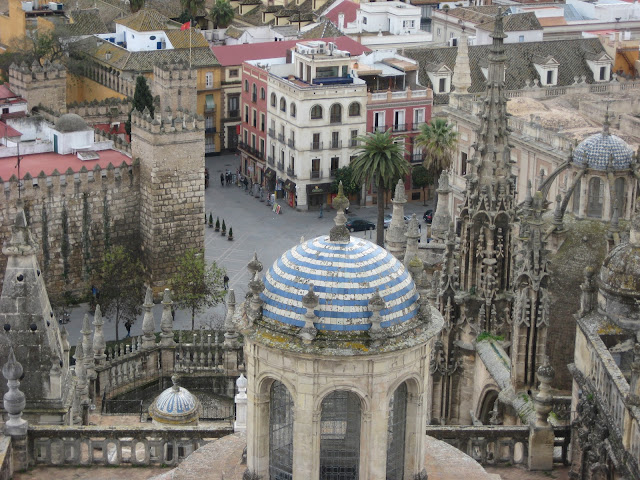Acronyms used in this post:
ICS: International College of Seville
CCIS: College Consortium for International Studies
SAGE: Study Abroad and Global Experience
This morning, Corin and I went to visit the International College of Seville. This visit was part of my sabbatical plan to further the goals of Valencia's Strategic Plan for International Education (for a copy of the plan, click
here)
Background: With Valencia's Study Abroad and Global Experience office (SAGE) I'm on two committees: (1) internationalizing the curriculum, and (2) international student recruitment and engagement (for full list of all SAGE committees and their members, click
here)
My first sabbatical goal is related to committee #1: To increase 'outward' internationalization by making connections (or strengthening existing connections) designed to 'increase the number of students on semester study abroad programs' (international plan, page 16). My second sabbatical goal is related to committee #2: To increase 'inward' internationalization by 'increasing international student enrollment' (international plan, page 21).
So, today's visit was related to goal one.
Why Seville? A few years ago, a group of Valencia faculty went to visit the International College of Seville, a CCIS center affiliated with Broward College, with a view to offering a study abroad in Seville option for Valencia students. Because the ICS is a CCIS center, all of the work to establish equivalencies has already been done, and their classes use the American course numbering system. For example, their SPN 1120 is Beginning Spanish I and counts as 3 credit hours. In case you haven't heard of CCIS (I was only vaguely aware of them before today) here is a brief explanation, copied from their website:
The College Consortium for International Studies, a partnership of colleges and universities -- two and four year, large and small, public and private, domestic and foreign -- encompasses the broad spectrum of international higher education. CCIS members sponsor a variety of programs, notably study abroad programs and professional development seminars for faculty and administrators, which are designed to enhance international/intercultural perspectives within the academic community.
If you'd like to know more about CCIS, here you go:
CCIS website
I was planning to be in the south of Spain in January, so I thought it could be useful to strengthen the connection already established between Valencia and the ICS by paying them another visit. Jennifer Robertson, director of SAGE, provided me with a site visit questionnaire, which would help give us the information we need to better promote the program to our students. So, this morning, Corin and I walked over to the International College of Seville, located just outside a beautiful city park.
Here's a picture of the park (and me in it):
Site visit at ICS, 1/16/13: We met with the director, Dr. Ignacio Martinez Rojas, and some of the faculty and staff. They were friendly, knowledgeable, and clearly dedicated to students. We discussed all aspects of the programs they offer, and I've listed the main points below:
- Classes have been assigned equivalent US college/university course numbers
- Classes are offered in Spanish language and culture
- Other classes are offered in English (for example, business classes)
- Professors have master's degree or higher
- Small class size (maximum of 15 students in language classes)
- Students can come for semester programs or summer programs
- Students stay in private homes (home stay)
- Students with advanced level of Spanish can also take classes at the University of Seville
- Extracurricular activities including excursions and service learning
There is lots more information available on their website -- check it out!
ICS website
Here are some pictures of the school with the director, faculty, and staff
We also got to visit one of their typical homestay providers, a short walk from the college along a street lined with orange trees. In fact, all the streets in Seville are lined with orange trees. The trees are full of oranges -- nobody picks them. (There's a lesson about supply and demand here somewhere, but I don't know what it is).
Here are some pictures from the homestay, showing a typical student room and the living/dining area.
Gina de los Santos is the housing director for the ICS; here she is in her office (and you may also recognize her in the pictures above)
Conclusion: As a result of my research and my visit to the college, I think it would be great to offer this program as one of Valencia's study abroad options. I liked everything about it -- the school, the staff, the homestays, and the city of Seville. The school adds some important personal touches; for example, they pick students up from the airport, they provide students with mobile phones, and they interview each student personally during a two-day orientation/placement period.
Lastly, see below for some miscellaneous pictures from around Seville.





























